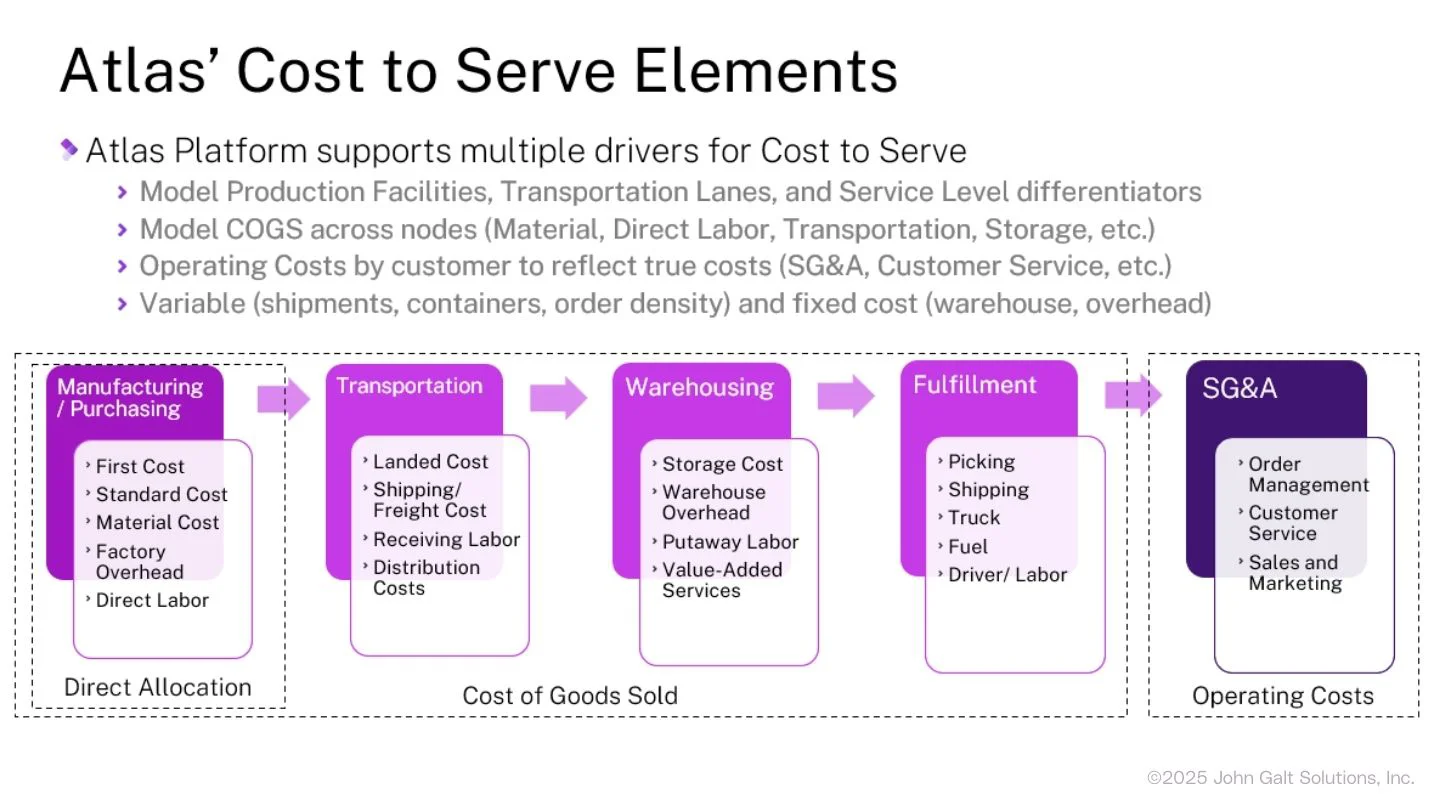Understanding and optimizing Cost to Serve (CTS) has become a critical challenge for businesses, as it directly impacts decision-making around pricing, service offering, and network design. Without a clear understanding of CTS, companies risk making uninformed decisions that can erode margins, misallocate resources and weaken competitive advantage.
Many organizations lack the systemic tools necessary to effectively evaluate and optimize Cost to Serve. Traditional CTS accounting falls short by failing to allocate costs of complexity introduced by different products, customers, and operational differentiators. This struggle is intensified by factors such as changing supply chain configurations, expanding product portfolios and differentiators like kitting or customizing, evolving business models due to acquisitions and market shifts.
As supply chains evolve, organizations need a more nuanced approach to analyze CTS, ensuring that decision-making is guided by accurate insights, rather than held back by limited visibility into the profitability of product portfolios and supply chain design and flow. Cost to Serve should drive recommendations and insights that align organizations around customer segmentation, optimizing networks and portfolios.
Key Considerations for Supply Chain Leaders
To address these challenges, supply chain leaders must consider:
- Scenario Planning: Running “what-if” analyses to anticipate how changes in demand, pricing, network design can impact cost structures, profitability, and more.
- Granular Cost Modeling: Understanding transaction, activity, and volume-based costs to optimize pricing and service strategies and offerings.
- Holistic Supply Chain Model & Optimization: Balancing trade-offs between cost, service levels, cash flow, and beyond.
- End-to-End Visibility: Incorporating data across transportation, warehouse management, manufacturing, logistics, and more to provide real-time, granular, cost insights.
How to Transform CTS Analysis: The Atlas Difference
The ultimate value of understanding Cost to Serve is driving informed decisions that enhance profitability and competitiveness. John Galt Solutions’ Atlas Planning Platform offers a comprehensive approach to CTS optimization, enabling you to leverage technology for greater control and visibility over supply chain costs. Here’s how:
1. What-If Scenario Modeling
One of Atlas’ key differentiators is its ability to model different scenarios and their impact on costs and profitability. Organizations can evaluate:
- True costs of product and service customizations
- Identify gain-share opportunities fulfillment options (ex: direct ship) for customers
- Impacts to costs of supply chain network configurations
- Identify cost savings and provide enhanced segmentation of products and customers
Users can also stress-test Cost-To-Serve assumptions:
- Shifts in customer demand or service options
- Cost fluctuations in raw materials and transportation
- Changes in product portfolio and pricing structures
- Impact of supply chain uncertainty and disruptions
Running these scenarios enables you to gain actionable insights to make proactive adjustments, ensuring alignment with long-term strategic goals.
2. Supporting Multiple Cost Drivers for Cost to Serve
Unlike traditional planning approaches that focus only on volume, Atlas supports a more comprehensive driver-based costing model that accounts for:
- Transaction-based costs, such as order processing and customer service expenses
- Activity-based costs, including fulfillment frequency and mode (e.g., full truckloads vs. partial loads), and product differentiation (like kitting or customizing).
- Volume-based costs, such as production efficiency and manufacturing batch sizes.
By leveraging these three key cost drivers, you gain deeper insights into their true Cost to Serve, allowing for stronger pricing and profitability analysis, and service optimization.

3. Holistic Supply Chain Model with MEIO
Atlas seamlessly integrates network configuration, multi-echelon inventory optimization (MEIO), and CTS analysis into a unified framework. This complete supply chain model enables companies to:
- Determine optimal manufacturing and distribution locations based on cost and capacity constraints
- Evaluate whether to route products through mixing warehouses or direct distribution centers
- Optimize inventory levels across different nodes to meet service level commitments while minimizing holding costs
- Ensure network design, inventory strategies, and cost structures are fully aligned
- Identify gain-share opportunities and to price different service offerings for customers
By combining network design with MEIO, Atlas provides a truly holistic approach to optimize CTS while maintaining operational agility.
4. Insights for Greater Visibility Across the End-to-End Supply Chain
With Atlas, you’re able to connect with other enterprise systems, including Transportation Management Systems (TMS), Warehouse Management Systems (WMS), Manufacturing Execution Systems (MES), and Labor Management Systems (LMS). This end-to-end visibility allows you to:
- Accurately model costs of products and services to improve pricing and profitability
- Adjust cost to serve data dynamically based on real-time data
- Improve decision-making through cross-functional insights
- Identify cost inefficiencies across the supply chain.
Drive Business Outcomes with Atlas
The Atlas Planning Platform empowers companies like yours to thoroughly understand what drives CTS and compare multiple scenarios to understand the impact on profitability, under different supply and demand conditions.
This analysis leads to enhanced cost transparency with a clear breakdown of CTS at the product, customer, and supply chain level; accurately price service customization; and improved profitability management based on aligning supply chain decisions with corporate financial goals.
By leveraging Atlas’ simultaneous multi-objective optimization, organizations can strike the right balance between cost reduction, customer service, and financial performance.
While traditional approaches fail to capture the complexity of today’s operations, we’re here to help you effectively model, analyze, and optimize CTS. Let us show you how advanced scenario planning, AI-driven recommendations, and integrated cost modeling in Atlas empowers you to make informed, strategic decisions that drive profitability and resilience.



